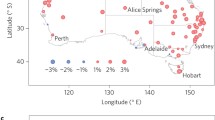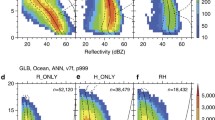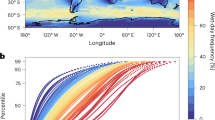Abstract
This study examines relationships between the extent of hurricane rain fields, storm size, and the environment surrounding the storm. A Geographic Information System is employed to measure the extent of the rain fields in each quadrant of 31 hurricanes at landfall-time. After correlating the extents with measures of storm size, multiple linear regression models are developed to determine which atmospheric forcing(s) at 0, 12, and 24 h prior to landfall are most highly related to rain field size in each quadrant. Results show that the radius of the outermost closed isobar encompasses the rain fields in 90% of the observations. Strong vertical wind shear from the southwest correlates with a larger (smaller) rain field extent toward the northeast (southwest), while higher relative humidity values correlate with a larger extent toward the northwest, southwest, and southeast. Storm intensity and location also exhibit statistically significant correlations with rain field size.








Similar content being viewed by others
References
Ansari S, Del Greco S (2005) GIS tools for visualization and analysis of NEXRAD radar (WSR-88D) archived data at the National Climatic Data Center. 21st international conference on Interactive Information Processing Systems (IIPS) for Meteorology, Oceanography, and Hydrology. American Meteorological Society, San Diego
Atallah EH, Bosart LR (2003) The extratropical transition and precipitation distribution of Hurricane Floyd (1999). Mon Wea Rev 131:1063–1081
Atallah EH, Bosart LF, Aiyyer AR (2007) Precipitation distribution associated with landfalling tropical cyclones over the eastern United States. Mon Wea Rev 135:2185–2206
Bell K, Ray PS (2004) North Atlantic hurricanes 1977–99: surface hurricane-force wind radii. Mon Wea Rev 132:1167–1189
Bender MA (1997) The effect of relative flow on the asymmetric structure in the interior of hurricanes. J Atmos Sci 54:703–724
Black ML, Gamache JF, Marks FD, Samsury CE, Willoughby HE (2002) Eastern Pacific Hurricanes Jimena of 1991 and Olivia of 1994: the effect of vertical shear on structure and intensity. Mon Wea Rev 130:2291–2312
Blackwell KG (2000) Evolution of Hurricane Danny (1997) at landfall: Doppler-observed eyewall replacement, vortex contraction/intensification, and low-level wind maxima. Mon Wea Rev 128:4002–4016
Bosart LF, Lackmann GM (1995) Postlandfall tropical cyclone reintensification in a weakly baroclinic environment—a case-study of Hurricane David (September 1979). Mon Wea Rev 123:3268–3291
Cecil DJ (2007) Satellite-derived rain rates in vertically sheared tropical cyclones. Geophys Res Lett 34:L02811
Chan JCL, Liu KS, Ching SE, Lai EST (2004) Asymmetric distribution of convection associated with tropical cyclones making landfall along the South China coast. Mon Wea Rev 132:2410–2420
Chen SYS, Knaff JA, Marks FD (2006) Effects of vertical wind shear and storm motion on tropical cyclone rainfall asymmetries deduced from TRMM. Mon Wea Rev 134:3190–3208
Corbosiero KL, Molinari J (2002) The effects of vertical wind shear on the distribution of convection in tropical cyclones. Mon Wea Rev 130:2110–2123
Corbosiero KL, Molinari J (2003) The relationship between storm motion, vertical wind shear, and convective asymmetries in tropical cyclones. J Atmos Sci 60:366–376
Cubukcu N, Pfeffer RL, Dietrich DE (2000) Simulation of the effects of bathymetry and land-sea contrasts on hurricane development using a coupled ocean-atmosphere model. J Atmos Sci 57:481–492
DeMaria M, Kaplan J (1994) A statistical hurricane intensity prediction scheme (SHIPS) for the Atlantic basin. Wea Forecast 9:209–220
DeMaria M, Kaplan J (1999) An updated Statistical Hurricane Intensity Prediction Scheme (SHIPS) for the Atlantic and eastern North Pacific basins. Wea Forecast 14:326–337
DeMaria M, Mainelli M, Shay LK, Knaff JA, Kaplan J (2005) Further improvements to the Statistical Hurricane Intensity Prediction Scheme (SHIPS). Wea Forecast 20:531–543
Demuth JL, DeMaria M, Knaff JA, Vonder Haar TH (2004) Evaluation of advanced microwave sounding unit tropical-cyclone intensity and size estimation algorithms. J Appl Meteor 43:282–296
Demuth JL, DeMaria M, Knaff JA (2006) Improvement of advanced microwave sounding unit tropical cyclone intensity and size estimation algorithms. J Appl Meteorol Climatol 45:1573–1581
Dunion JP, Velden CS (2004) The impact of the Saharan air layer on Atlantic tropical cyclone activity. Bull Am Meteor Soc 85:353
Dunn GE, Miller BI (1960) Atlantic Hurricanes. Louisiana State University Press, Baton Rouge, p 326
Dvorak VF (1975) Tropical cyclone intensity analysis and forecasting from satellite imagery. Mon Wea Rev 103:420–430
Elsberry RL (2002) Predicting hurricane landfall precipitation: Optimistic and pessimistic views from the symposium on precipitation extremes. Bull Am Meteorol Soc 83:1333–1339
Evans JL, Hart RE (2003) Objective indicators of the life cycle evolution of extratropical transition for Atlantic tropical cyclones. Mon Wea Rev 131:909–925
Frank WM (1977) The structure and energetics of the tropical cyclone I. Storm structure. Mon Wea Rev 105:1119–1135
Frank WM, Ritchie EA (1999) Effects of environmental flow upon tropical cyclone structure. Mon Wea Rev 127:2044–2061
Frank WM, Ritchie EA (2001) Effects of vertical wind shear on the intensity and structure of numerically simulated hurricanes. Mon Wea Rev 129:2249–2269
Gray WM (1979) Tropical cyclone intensity determination through upper-tropospheric aircraft reconnaissance. Bull Am Meteor Soc 60:1069–1074
Hanley DE (2002) The evolution of a hurricane-trough interaction from a satellite perspective. Wea Forecast 17:916–926
Hanley D, Molinari J, Keyser D (2001) A composite study of the interactions between tropical cyclones and upper-tropospheric troughs. Mon Wea Rev 129:2570–2584
Harr PA, Elsberry RL (2000) Extratropical transition of tropical cyclones over the western north pacific. Part I: evolution of structural characteristics during the transition process. Mon Wea Rev 128:2613–2633
Harr PA, Elsberry RL, Hogan TF (2000) Extratropical transition of tropical cyclones over the western North Pacific. Part II: the impact of midlatitude circulation characteristics. Mon Wea Rev 128:2634–2653
Hart RE, Evans JL (2001) A climatology of the extratropical transition of Atlantic tropical cyclones. J Climate 14:546–564
Hill K, Lackmann GM (2009) Influence of environmental humidity on tropical cyclone size. Mon Wea Rev 137:3294–3315
Jarvinen BR, Neumann CJ, Davis MAS (1984) A tropical cyclone data tape for the north Atlantic basin, 1886–1983. NOAA Tech Memo NWS NHC 22, Miami, p 21
Jiang HY, Halverson JB (2008) On the differences in storm rainfall from Hurricanes Isidore and Lili. Part II: water budget. Wea Forecast 23:44–61
Jiang HY, Halverson JB, Simpson J, Zipser EJ (2008a) Hurricane “Rainfall Potential” derived from satellite observations aids overland rainfall prediction. J Appl Meteorol Climatol 47:944–959
Jiang HY, Halverson JB, Zipser EJ (2008) Influence of environmental moisture on TRMM-derived tropical cyclone precipitation over land and ocean. Geophys Res Lett 35. doi:10.1029/2008gl034658
Jones SC, Harr PA, Abraham J, Bosart LF, Bowyer PJ, Evans JL, Hanley DE, Hanstrum BN, Hart RE, Lalaurette F, Sinclair MR, Smith RK, Thorncroft C (2003) The extratropical transition of tropical cyclones: forecast challenges, current understanding, and future directions. Wea Forecast 18:1052–1092
Kaplan J, DeMaria M (1995) A simple empirical-model for predicting the decay of tropical cyclone winds after landfall. J Appl Meteor 34:2499–2512
Kidder SQ, Kusselson SJ, Knaff JA, Ferraro RR, Kuligowski RJ, Turk M (2005) The tropical rainfall potential (TRaP) technique. Part I: description and examples. Wea Forecast 20:456–464
Kimball SK (2008) Structure and evolution of rainfall in numerically simulated landfalling hurricanes. Mon Wea Rev 136:3822–3847
Kimball SK, Mulekar MS (2004) A 15-year climatology of North Atlantic tropical cyclones. Part I: size parameters. J Climate 17:3555–3575
Klein PM, Harr PA, Elsberry RL (2000) Extratropical transition of western North Pacific tropical cyclones: an overview and conceptual model of the transformation stage. Wea Forecast 15:373–395
Konrad CE (2001) The most extreme precipitation events over the eastern United States from 1950 to 1996: considerations of scale. Journal of Hydrometeorology 2:309–325
Liu KS, Chan JCL, Cheng WC, Tai SL, Wong PW (2007) Distribution of convection associated with tropical cyclones making landfall along the South China coast. Meteorol Atmos Phys 97:57–68
Liu GR, Chao CC, Ho CY (2008) Applying satellite-estimated storm rotation speed to improve typhoon rainfall potential technique. Wea Forecast 23:259–269
Lonfat M, Marks FD, Chen SYS (2004) Precipitation distribution in tropical cyclones using the Tropical Rainfall Measuring Mission (TRMM) Microwave Imager: a global perspective. Mon Wea Rev 132:1645–1660
Lonfat M, Rogers R, Marchok T, Marks FD (2007) A parametric model for predicting hurricane rainfall. Mon Wea Rev 135:3086–3097
Maclay KS, DeMaria M, Vonder Haar TH (2008) Tropical cyclone inner-core kinetic energy evolution. Mon Wea Rev 136:4882–4898
Marks FD (1985) Evolution of the structure of precipitation in Hurricane Allen (1980). Mon Wea Rev 113:909–930
Matyas CJ (2010) A geospatial analysis of convective rainfall regions within tropical cyclones after landfall. Int J Appl Geospat Res (in press)
Medlin JM, Kimball SK, Blackwell KG (2007) Radar and rain gauge analysis of the extreme rainfall during Hurricane Danny’s (1997) landfall. Mon Wea Rev 135:1869–1888
Merrill RT (1984) A comparison of large and small tropical cyclones. Mon Wea Rev 112:1408–1418
Merrill RT (1988) Environmental-influences on hurricane intensification. J Atmos Sci 45:1678–1687
Miller BI (1958) Rainfall rates in Florida hurricanes. Mon Wea Rev 258-264
Milrad SM, Atallah EH, Gyakum JR (2009) Dynamical and precipitation structures of poleward-moving tropical cyclones in eastern Canada, 1979–2005. Mon Wea Rev 137:836–851
Moyer AC, Evans JL, Powell M (2007) Comparison of observed gale radius statistics. Meteorol Atmos Phys 97:41–55
Mueller KJ, DeMaria M, Knaff J, Kossin JP, Vonder Haar TH (2006) Objective estimation of tropical cyclone wind structure from infrared satellite data. Wea Forecast 21:990–1005
Peng MS, Maue RN, Reynolds CA, Langland RH (2007) Hurricanes Ivan, Jeanne, Karl (2004) and mid-latitude trough interactions. Meteorol Atmos Phys 97:221–237
Powell MD (1987) Changes in the low-level kinematic and thermodynamic structure of Hurricane Alicia (1983) at landfall. Mon Wea Rev 115:75–99
Rappaport EN (2000) Loss of life in the United States associated with recent Atlantic tropical cyclones. Bull Am Meteor Soc 81:2065–2073
Ritchie EA, Elsberry RL (2001) Simulations of the transformation stage of the extratropical transition of tropical cyclones. Mon Wea Rev 129:1462–1480
Rodgers EB, Pierce HF (1995) Environmental influence on Typhoon-Bobbie precipitation distribution. J Appl Meteor 34:2513–2532
Rodgers EB, Chang SW, Stout J, Steranka J, Shi JJ (1991) Satellite-observations of variations in tropical cyclone convection caused by upper-tropospheric troughs. J Appl Meteor 30:1163–1184
Rodgers EB, Baik JJ, Pierce HF (1994) The environmental influence on tropical cyclone precipitation. J Appl Meteor 33:573–593
Rodgers EB, Olson WS, Karyampudi VM, Pierce HF (1998) Satellite-derived latent heating distribution and environmental influences in Hurricane Opal (1995). Mon Wea Rev 126:1229–1247
Rodgers E, Olson W, Halverson J, Simpson J, Pierce H (2000) Environmental forcing of supertyphoon Paka’s (1997) latent heat structure. J Appl Meteor 39:1983–2006
Rogers RF, Chen SS, Tenerelli J, Willoughby HE (2003) A numerical study of the impact of vertical shear on the distribution of rainfall in Hurricane Bonnie (1998). Mon Wea Rev 131:1577–1599
Shapiro LJ (1983) The asymmetric boundary-layer flow under a translating hurricane. J Atmos Sci 40:1984–1998
Shapiro LJ, Moller JD (2003) Influence of atmospheric asymmetries on the intensification of Hurricane Opal: piecewise PV inversion diagnosis of a GFDL model forecast. Mon Wea Rev 131:1637–1649
Tuleya RE, DeMaria M, Kuligowski RJ (2007) Evaluation of GFDL and simple statistical model rainfall forecasts for US landfalling tropical storms. Wea Forecast 22:56–70
Vieux BE, Bedient PB (1998) Estimation of rainfall for flood prediction from WSR-88D reflectivity: a case study, 17–18 October 1994. Wea Forecast 13:407–415
Willoughby HE, Marks FD, Feinberg RJ (1984) Stationary and moving convective bands in hurricanes. J Atmos Sci 41:3189–3211
Zheng X, Duan YH, Yu H (2007) Dynamical effects of environmental vertical wind shear on tropical cyclone motion, structure, and intensity. Meteorol Atmos Phys 97:207–220
Acknowledgments
The author wishes to thank Kevin Ash and Dr. Mark DeMaria for their comments on earlier drafts of this manuscript. The comments of two reviewers were extremely helpful in producing the final draft of the manuscript.
Author information
Authors and Affiliations
Corresponding author
Rights and permissions
About this article
Cite this article
Matyas, C.J. Associations between the size of hurricane rain fields at landfall and their surrounding environments. Meteorol Atmos Phys 106, 135–148 (2010). https://doi.org/10.1007/s00703-009-0056-1
Received:
Accepted:
Published:
Issue Date:
DOI: https://doi.org/10.1007/s00703-009-0056-1




